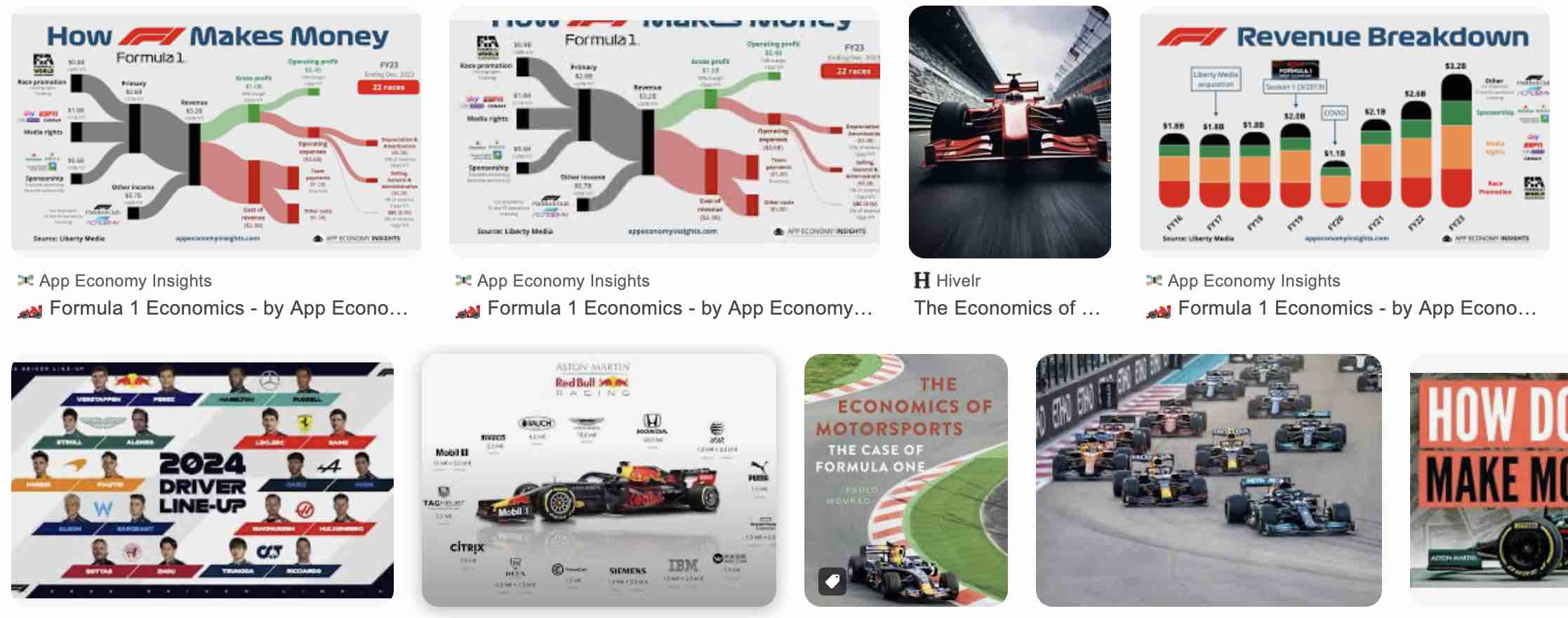The Economics of Formula 1: Examining Revenue Models and Financial Strategies
Formula 1 is not just a high-speed show involving high-tech facilities and breathtaking driving skills. It is a rather complicated multi-level economic domain that successfully implements heterogeneous types of revenue and a range of grand financial strategies. This article is devoted to exploring the financial features of Formula 1 and clarifying the ways it receives profit and stays financially strong while still developing and keeping its audience.
Revenue Streams in Formula 1
Formula 1’s financial prowess stems from a multifaceted revenue model that includes race hosting fees, broadcasting rights, sponsorships, and merchandise sales.
1. Race Hosting Fees
One of the primary contenders for Formula 1 revenue is the hosting fees paid by countries and cities. It can range from $20 million up to $50 million for every event. The value of the Grand Prix does not rely on the running of the event but its global exposure which enables the country to boost its tourism and local economy. Each Grand Pix has a different value of fee depending on the host’s infrastructure and how much the Grand Pix is marketable. The length of the contract also plays out here.
2. Broadcasting Rights
The second important source of income is the broadcasting rights. After all, media companies all over the world pay a lot of money to the series which can provide a broad range of activities, such as live and highlighted races, and special films and videos. Moreover, not only Formula 1 but also the broadcasters get benefits from these rights because F1 receives a stable source of income and the broadcasters get more viewers and advertise their channels. Nowadays, platforms like Netflix and Amazon Prime are also involved in this business and sign deals allowing them to stream races to the ever-increasing viewers.
3. Sponsorships and Advertising
As much as the primary racing events, sponsorship deals are central to the financial continuous of the F1, as well as possibly its teams this is because corporations pay huge sums to oust their logos on cars, drivers’ suits, and other relevant branding prospects over the course of the weekend races.
Companies and industries can also benefit from the association with the glamor, prestige, and excitement that are usually associated with F1 events, and there are several examples of global corporations that invest their considerable funds into the provision of such sponsorship for F1 races, the examples include Petronas, Shell, Pirelli, and Heineken.
4. Merchandise Sales
Merchandise sales are another revenue source, especially through official stores and online platforms. It is not a secret that fans tend to buy whatever item associated with the sport in order to show their support and allegiance to the teams and drivers they admire.
That is the reason for the high importance of merchandise sales, as it continuously builds fans’ engagement and loyalty alongside the income flow. Both official store locations and online selling have a variety of goods to offer, as F1 constantly bombards consumers with new items and limited editions.
Financial Strategies in Formula 1
F1’s financial strategies are as dynamic and sophisticated as the sport itself. These strategies ensure F1 remains at the forefront of global sports entertainment while maintaining financial stability.
1. Cost Cap Implementation
One of the biggest steps toward cost awareness in the recent past was the cost cap applied to teams’ budgets. Proposed in 2021, the policy was created to reduce the gap between the top teams with seemingly unlimited budgets and the smaller ones, also for the sake of making racing more competitive and less predictable. Moreover, by limiting expenditures, the system coordinates the teams to spend smarter, forcing them to increase investments in areas of major performance returns. Lastly, by putting a ceiling on expenditures, F1 managed to prevent a financial war that would eventually put the sport in danger, making it impossible to play in the long run.
2. Revenue Sharing Model
Formula 1 employs a revenue-sharing model for income distribution among the teams that participate in the contests. Additionally to the resources or means that a team contributes, sharing of revenue is also dependent on the number of wins it secures as well as its overall performance in the history of the contests. This model is typical as it ensures that even the teams that do not win or perform very well receive a fair share of revenue. This system is useful to ensure that the competition remains safe and viable in the long term.
3. Diversifying Event Locations
By diversifying the locations of F1 races, the sport can tap into new markets and expand its global footprint. Recent additions to the calendar, such as races in Vietnam and Saudi Arabia, underline F1’s strategy to reach new audiences. These new locations often involve lucrative hosting fees and sponsorship deals that bolster F1’s financial standing. Additionally, they bring the sport closer to fans in different regions, driving engagement and merchandise sales.

The Impact of COVID-19
The current maltreatment of COVID-19 has dramatically affected Formula 1 finances. If not for a good mix of revenue streams strategic move, the situation would have been worse. In 2020, the world was hit by a pandemic, and several races were canceled or postponed. Such moves threatened the flow of revenue with respect to reduced hosting fees and broadcasting monies. The good news was the resilience to money-related losses was achieved through a contract renegotiation mode, cost farming, and an adaptable calendar for the case of races.
The COVID-19 scenario of the Formula 1 Pre-Season has required that the entity introduce strong cost-saving measures. In this respect, the implementation of the cost cap was accelerated, and the renegotiation of broadcasting rights took place. Thus, not only has Formula 1 undergone significant changes, but the teams have also adopted some harsh tactics, such as the furloughing of the workers, in an unprecedented attempt to save money.
Despite the extremity of the aforementioned measure, the early announcement of the team budget cap along with the discussion of the future restrictions has helped the Formula 1 management carefully adjust the schedule, and the revised 17-race calendar has been held in 2020. Therefore, it can be assumed that Formula 1 has proven the impressive resilience of its financial situation and will be able to recover even more successfully. Finally, the promotion of new sponsors and the use of new technologies for additional revenue will also benefit the Formula 1 financial future.
Conclusion:
Formula 1’s financial prowess is a testament to its ability to innovate, adapt, and leverage diverse revenue streams. From race hosting fees and broadcasting rights to sponsorships and merchandise sales, F1 has crafted a comprehensive financial strategy that ensures its long-term sustainability. The implementation of cost caps, revenue-sharing models, and digital transformation initiatives further solidify F1’s position as a global sports and entertainment powerhouse.







